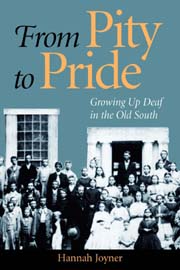Growing Up Deaf in the Old South
Hannah Joyner
|
Read chapter seven. Read reviews: Choice, Daily News, Disability Studies Quarterly, The Journal of American History, The Journal of Southern History. |
$57.50s print edition $57.50 e-book |
From Daily News, Bowling Green, KY
No matter the era in which one grows up, deafness is a condition that can bring out the worst and the best not only in those people so afflicted but also in those who live and associate with them. So many times, people of goodwill mistakenly show pity for those with disabilities; this is usually out of sympathy, not some kind of ignorance of the human condition. The author of this slim volume had surgery that caused a hearing loss that led to research into her “historical interest in discrimination and resistance.” Hence, this book.
Some people are deaf at birth, others lose hearing through traumatic experiences and still others because of the aging process. No matter the reason, the victims are deprived of not only the beautiful but as well the “ugly” sounds of the earth. How to teach the deaf to communicate with the hearing world is the question here.
First, it is “articulation.” Perhaps, some deaf people, at least those who were not deaf at birth, can be taught at least a few elements of the English language. The sounds, however, become invariably different from those of usual English speakers and lead to much confusion and anguish. The next approach is “sign language,” approved by the American Sign Language (ASL) association, which has created the closest thing yet to a universal “deaf” language. And then there is the “read and write” method of communication, by which deaf people can connect with the hearing.
Author Joyner discusses some of the more active schools or “asylums,” as they were invariably called. One of the earliest was in Kentucky, whose hearing director, 19-year-old John Adamson Jacobs, had to be sent off to school himself to learn ASL. Other early southern states that created schools for the deaf included Alabama, Mississippi and Georgia. Deaf students (at least the white ones) were admitted to these schools regardless of social and economic standing. If their parents could not pay full tuition, the state usually made up the difference.
Unfortunately, as sectional rancor rose between the North and South in the l840s and ‘50s, directors of these southern schools were sometimes judged more by their “loyalty to the South” than any ability to teach and administer. In fact, the principal of Georgia’s School for the Deaf, S.F. Dunlap, was chastised by the governor himself, fearing that Dunlap could be “instilling into the minds of our youth sentiments of hostility to the South.” Thus, once again, real progress had to take a back seat to political opportunism.
Joyner picks two or three specific families who coped with deafness in the antebellum South, all of whom had enough money, property and influence to get people to listen (figuratively and literally) to them, to delineate what it “was like” to be ‘in the American South before the Civil War. One of her first examples was Jefferson Trist, of the diplomatic family that had a great deal to do with ending the Mexican War in 1848.
She moves on then to Samuel and Jane Tillinghast, who visited a northern “Deaf and Dumb Asylum” to determine what to do with their young deaf son, David. They left him there with all the uncertainties and fears of suddenly being “abandoned” in a strange, unfriendly place.
The most interesting individual discussed by author Joyner was John Jacobus Flournoy from Georgia. Coming to believe that governments, local, state and federal, were not doing enough for the deaf community, Flournoy got into politics himself, running — without success — for numerous offices. He traveled to Washington, D.C., to ask his relative, Howell Cobb, for a government position. Cobb “laughed at him, gave him money, and sent him home” (p. 113).
Ultimately, Flournoy conceived of a scheme to create a “Deaf Mute Republic,” probably somewhere west of the Mississippi River, made up, of course, of only deaf people. This utopian society was to be named one of several suggestions put forward for it: Deaf-Mutia, Gesturia, Land of Gallaudet, or Eyeth (instead of “EARth) (p. 118). He would ban all hearing people from this society, ignoring the fact that since over 90 percent of children born to deaf parents are hearing, he and his compatriots would ultimately have to expel their own children from their homeland! (p. 116)
Ms. Joyner is an independent historian who lives in Takoma Park, Md. Her present offering should be of interest not only to the general reader but to “case specific” examples in various classrooms. It is well documented with endnotes, bibliography and a well-constructed index. This book is a valuable contribution to the field of disability history.
Hannah Joyner is an independent historian in Takoma Park, MD.
Print Edition: ISBN 978-1-56368-270-4, 6 x 9 casebound, 224 pages, references, index
$57.50s
E-Book: ISBN 978-1-56368-316-9
$57.50
To order by mail, print our Order Form or call:TEL 1-800-621-2736; (773) 568-1550 8 am - 5 pm CST
TTY 1-888-630-9347
FAX 1-800-621-8476; (773) 660-2235
